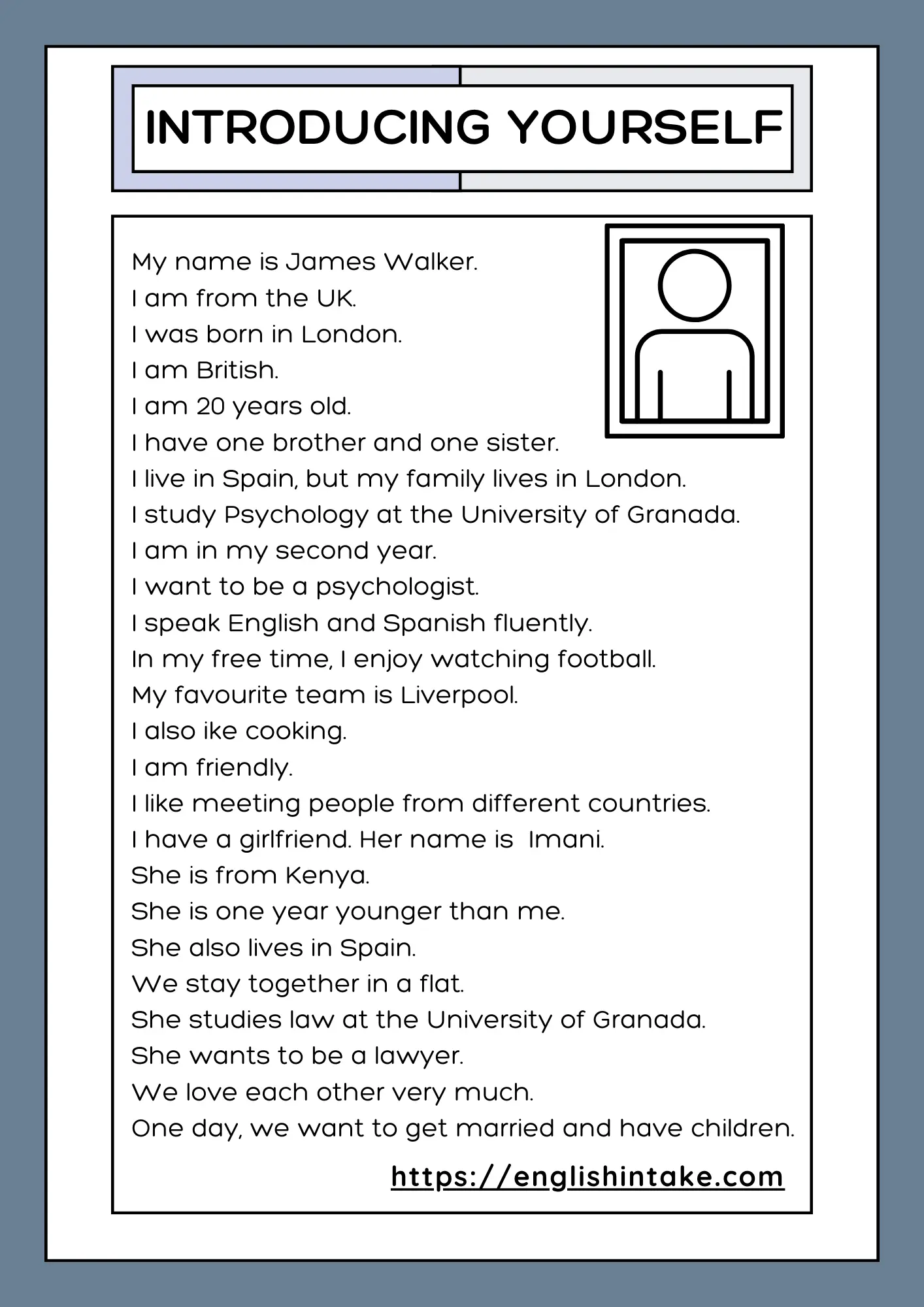1. A simple way to talk about yourself in English
To introduce yourself, you can follow the guidelines below.
greet your audience
Good morning.
say your name
My name is Emi.
mention where you are from
I am from Japan.
talk about your age if you want
I am 20 years old.
say what you do
I work as a general manager at T-mobile.
share one or two things you like
I like reading books.
add something friendly, like “It's a pleasure to be with you today.”
It's a pleasure to be with you today.
Here are some more examples of self-introduction in English.
Hello, I’m Jane. I’m from Australia. I work as a graphic designer. I’m married, and I have two children. My wife is Japanese. She is from Tokyo. In my free time, I love hiking and reading.
In real conversation, you do not need to talk about everything. If you meet someone for the first time, it’s enough to say your name and what you do for a living. If the other person wants to know more, then you can talk more about yourself. Let’s study the example below.
Anna: Hello, I’m Anna.
Leo: Hi Anna. I’m Leo. Nice to meet you.
Anna: Nice to meet you too. What do you do?
Leo: I work in a bank. And you?
Anna: I’m a teacher.
Leo: Great! Where are you from?
Anna: I’m from Italy.
My name is Sarah. I’m from England, but I’ve lived in the US for 10 years. I live in Chicago. I was born on the 5th of May 1998. I’m 35 years old. My birthday is on the 5th of May. I’m a teacher. I have a D. Litt. (Doctor of Letters) in English from the University of Oxford. I’ve been teaching for 5 years.
I’m married. My husband’s name is Robert. He works as an engineer for Google. We have been married for 10 years. We have two children. My son’s name is Khan. He is 5 years old. My daughter’s name is Lily. She’s 3 years old. I love spending time with my family when I’m not working.
I like being physically active. I’m a keen basketball player. I’ve been playing basketball since I was in high school. I also enjoy reading books. My favourite author is J. K. Rowling. I’m an outgoing person, and I like hanging out with my friends.

2. Questions and possible answers
Introducing your name.
- What’s your name?
- What should I call you?
- I don’t think we’ve been introduced yet. My name is Jake. What’s yours?
- I don’t think I’ve met you before. I’m Jack. What’s your name?
- May I have your name, please?
- Could you tell me your name, please?
Possible answers
1. My name is .... (name)
My name is Jack.
2. I’m .... (name)
I’m Clara.
3. I’m .... (name), but you can call me.... (nickname)
I’m Bradley, but you can call me Brad.
4. I’m .... (name), but people call me .... (nickname)
I’m Bradley, but people call me Brad.
Talking about your country of origin.
- Where are you from?
- Where do you come from?
- Where are you from originally?
Possible answers
1. I’m from .... (country)
I’m from France.
2. I come from .... (country)
I come from France.
3. I hail from .... (place)
I hail from West Virginia.
4. I’m originally from .... (country)
I’m originally from South Africa.
Mentioning your place of birth.
- Where were you born?
- What is your place of birth?
- In which city were you born?
- In which town were you born?
Possible answers
1. I was born in .... (place or country)
I was born in Barcelona.
I was born in Spain.
2. My place of birth is .... (place)
My place of birth is Heidelberg.
Describing family members.
- How many people are there in your family?
- How many siblings do you have?
- Do you have any siblings?
- Do you have any brothers and sisters?
Possible answers
1. We are a family of .... (numbers)
We are a family of five.
2. I have .... (number of brothers and sisters)
I have two brothers and one sister.
3. Yes, I have .... and ....
Yes, I have two brothers and one sister.
No, I’m an only child.
Speaking about your place of residence.
- Where do you live?
- What’s your current address?
- What’s your street address?
- Could you give me your street address, please?
- May I have your address, please?
Possible answers
1. I live in .... (place)
I live in London.
2. It’s....(address) or My address is ....(address)
It’s 57 Queen Street, E1 7AA, London.
My address is 57 Queen Street, E1 7AA, London.
* People ask these questions when they want to know your exact location. For example, when they need your address for administration purposes.
Introducing your work.
- What do you do?
- What do you do for living?
- What’s your job?
Possible answers
1. I’m a/ an .... (job title)
I’m a doctor.
2. I work as a / an .... (job title) for .... (company)
4. I work as a mechanical engineer for NASA.
3. I work for .... (company) as a / an .... (job title)
I work for NASA as a mechanical engineer.
4. I’m responsible for .... (job responsibility) at .... (company)
I’m responsible for analysing customer feedback at Amazon.
5. As a .... (job title) at.... (company), I’m responsible for ....(job responsibility)
As a software engineer at ByteWorks, I’m responsible for developing and maintaining web applications.
6. I’m a ....(job title). My work involves ..... (job responsibility).
I’m a data scientist at McKinsey & Company. My work involves analysing large and complex data sets to identify patterns and solve business problems for our clients.
7. I’m .... (Job status)
I’m unemployed.
I’m jobless.
I’m looking for a job.
I’m looking for work.
I’m retired.
Discussing your hobbies and interests.
- What do you do in your free time?
- What’s your favourite ....(e.g., sport, food, etc.)?
- Who’s your favourite ....(e.g., actor, actress, writer, etc.)
- What’s your hobby?
- What do you like to do in your spare time?
Possible answers
1. I like playing the guitar in my free time.
2. In my free time, I like playing the guitar.
3. In my spare time, I like hanging out with my friends.
4. When I have free time, I usually catch up on my reading.
5. I mostly spend my free time on TikTok.
6. I usually spend my free time doing nothing.
7. I enjoy surfing and skiing.
12. I enjoy swimming.
8. I’m into cycling.
9. My hobbies are skateboarding, skydiving, windsurfing, and ice skating.
10. My favourite sport is football.
Saying how old you are.
- How old are you?
Possible answers
1. I’m .... years old.
I’m twenty years old.
2. I’m in my ....*
I’m in my thirties.
3. I’m in my early ....*
I’m in my early forties.
4. I’m in my late ....*
I’m in my late sixties.
Asking someone’s age may not always be appropriate. You may only want to do so if you know the person well.
*You could say these when you don’t want to tell your exact age.
3. Useful tips for engaging in conversation
Use body languageSmile, maintain eye contact, and offer a handshake if it’s appropriate.
Ask about the other personAfter introducing yourself, ask the other person about themselves. You can use simple questions like, "And you?", "What about you?", or "How about you?".
Listen to the speakerWhen the other person is introducing themselves, be sure to listen. Not only is it courteous, but it also helps you remember details for future conversations.
Tailor your introductionDepending on the situation, you might adjust the information you provide. For instance, at a professional event, focus on your job or field of expertise. At a casual gathering, you can talk about hobbies and personal interests.
Learn cultural nuancesIn some cultures, certain details might be more important than others. For instance, in a business setting in Japan, exchanging business cards is a critical part of an introduction.
Practice your conversationThe more you practice your introduction, the more confident you’ll become. Try rehearsing in front of a mirror or with a friend.
4. Common mistakes
Being too long-windedKeep your introduction concise. Avoid going into lengthy stories unless you are asked to do so.
Forgetting to smileDon’t forget to smile when it is appropriate. It can make your introduction more approachable.
Speaking too quicklyEspecially if you’re nervous, you might rush through your introduction. Take a deep breath and pace yourself.
Neglecting to listenOnce you’ve introduced yourself, ensure you listen to the other person’s introduction. This shows respect and helps in building relationship.
To test your vocabulary skills, try these introduce yourself exercises.
